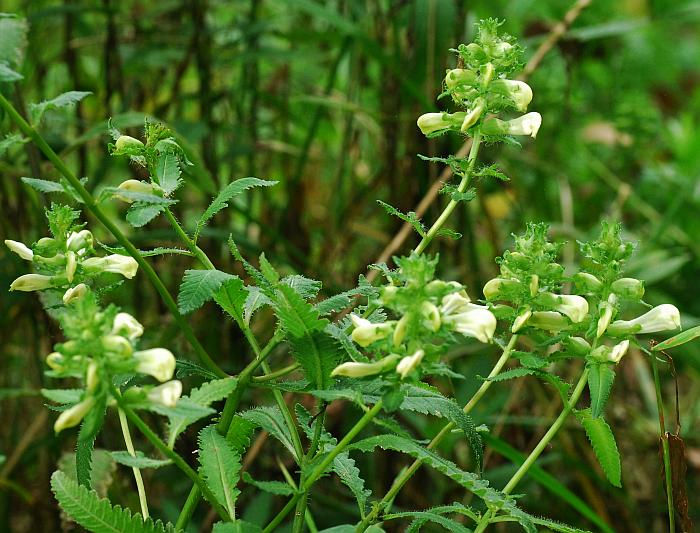Pedicularis lanceolata Michx.
Swamp Lousewort

Native
CC = 9
CW = -5
MOC = 25
© SRTurner
Pedicularis lanceolata Michx.Swamp Lousewort | |
 |
Native CC = 9 CW = -5 MOC = 25 |
© SRTurner |
|
Family - Orobanchaceae Habit - Fibrous-rooted perennial forb, not colonial, lacking rhizomes and stolons. Stems - Erect, or reclining with age, to 80 cm, hollow, slightly 4-angled, glabrous toward the base, moderately to densely hairy toward the tip and inflorescence axis.
Leaves - Opposite, simple, decussate. Basal leaves absent at flowering. Lower stem leaves short-petiolate or sessile. Petioles to 1 cm long, mostly glabrous but with a few multicellular hairs on the margins. Leaf blades 3-12 cm long, narrowly oblong-lanceolate to narrowly elliptic, lobed less than half way to the midvein, the lobes finely toothed or scalloped, unlobed, with a narrow, pale band along the margins, the surfaces sparsely to moderately hairy, sometimes mostly along the veins. Lateral veins of leaf impressed above, expressed below. Veins in a minute reticulate pattern, visible abaxially.
Inflorescence - Terminal and axillary bracteate spikes, the bracts with a distinctly bent petiole and a pair of spreading basal auricles, folded in at least the basal 1/2, accrescent, 1.5 cm long in flower, with a few marginal hairs, otherwise glabrous, with crenulate-serrulate margins, the flower stalks absent or to 2 mm long, relatively dense. Flowers of the spike arranged in a pinwheel fashion as viewed end-on.
Flowers - Calyces 8-12 mm long, oblique, the tube with a pair of rounded, appendagelike, lateral lobes, the upper and lower margins truncate or broadly notched. Corollas zygomorphic, bilabiate, 15-27 mm long, pale yellow to cream-colored or nearly white, the upper lip galeate, 8-13 mm long, narrowed to a beaklike, unlobed tip (rarely minutely notched), the lower lip 7-12 mm long, ascending to slightly spreading, somewhat incurved, the central lobe extending past the lateral ones. Stamens 4, included in the galea of the upper lip. Filaments thin, translucent-white, mostly glabrous but with some hairs at the base, 2.0-2.5 cm long, compressed. Anthers yellow-brown, 3-4 mm long. Style white, 3 cm long, glabrous. Stigma minute and green. Ovary green, conic, slightly compressed, glabrous, 3 mm long in flower, with a swollen nectariferous base, 2-locular. Ovules many. Placentation axile.
Fruit - Capsules 8-11 mm long. Seeds 2.5-3.2 mm long, more or less semicircular to slightly kidney-shaped in outline, strongly flattened, the brown to dark brown, somewhat thickened body surrounded on 3 sides by a prominent, lighter brown wing, this rounded at each end, the surface with a very fine (visible only under magnification) and often faint network of ridges.
Flowering - August - October. Habitat - Fens, calcareous seeps, spring-fed swampy meadows, moist limestone ledges. Origin - Native to the U.S. Lookalikes - P. canadensis. Other info. - This plant is found in three distinct clusters of counties in Missouri, mainly in the southern half of the state. The Ozark populations lie at the far southwestern extent of the plant's normal range, which is mainly in the upper U.S. Midwest and Canada. The plant is relatively easy to identify from its distinctively margined leaves and inflorescences with a pinwheel appearance from above. The plant is distinguished from P. canadensis by habitat, as it is always found in wet places such as fens. In addition, P. canadensis usually has distinctly yellow flowers, alternate upper stem leaves, and basal leaves which are usually persistent at flowering. Photographs taken in Alley Spring Park, Shannon County, MO., 9-29-03 (DETenaglia); also at Shaw Nature Reserve, Franklin County, MO, 9-10-2015, and Cruise Mill fen, Washington County, MO, 9-24-2018 (SRTurner). |